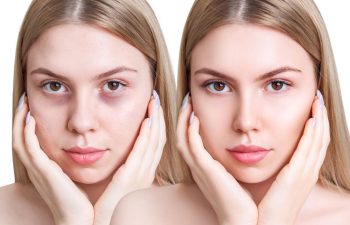
Dark circles under the eyes are common. Most people get them at some point, especially from lack of sleep. The dark circles make you look tired. While they can affect anyone, they are more common among older adults.
Some people are genetically predisposed to the condition. Individuals with darker skin tones and prone to hyperpigmentation around the eyes are more likely to get dark circles.
WHAT CAUSES UNDER-EYE CIRCLES
Dark circles under the eyes do not usually require medical attention. Common causes of the circles include the following:
- Fatigue, sleep deprivation, or oversleeping can cause the formation of dark eye circles.
- Dehydration is a common cause of under-eye circles. It causes the skin under the eyes to look dull and sunken.
- As people age, the skin becomes thinner due to the reduction of fat and collagen. When this happens, the dark blood vessels become visible.
- Genetics can cause the development of dark under-eye circles. It can be an inherited trait evident even in childhood.
- Allergies and eye dryness can cause dark circles under the eyes. Histamines released by the body cause dilation of blood vessels.
- Eyestrain due to prolonged digital screen use can cause the blood vessels around the eyes to enlarge.
- Overexposure to the sun causes the skin to produce excess melanin, causing the skin to darken.
- Anemia occurs when red blood cell levels are lower than usual. It can lead to dark circles under the eyes.
HOME REMEDIES FOR UNDER-EYE CIRCLES
There are home remedies that can help rid under-eye circles. They include placing a cold compress over the eyes to reduce swelling, getting extra sleep, and elevating your head while sleeping.
Drink plenty of water and other fluids to stay hydrated. Placing soaked tea bags over the eyelids can help reduce liquid buildup, shrink blood vessels, and stimulate blood circulation. Tropical eye creams can help reduce the appearance of dark circles.
TREATMENT FOR UNDER-EYE CIRCLES
Some treatments can reduce dark circles permanently. Treatment depends on the underlying cause, and the options include:
- Laser surgery for skin resurfacing.
- Chemical peels that reduce pigmentation.
- Skin lightening creams.
- Tissue fillers that help conceal blood vessels.
- Fat removal procedure that helps remove excess skin and fat.
- Medical tattoos that involve the injection of pigment into the thinning skin.
- Carboxytherapy that increases blood flow to the under-eye area.
- Surgical implants that use fat or synthetic products.
PREVENTING UNDER-EYE CIRCLES
Dark circles are not necessarily a symptom of a medical issue and are not usually cause for concern. Most people look to get rid of them for cosmetic reasons. Making some lifestyle changes can help. Managing stress, adjusting your sleep schedule, and using sun protection can help. It also helps to reduce alcohol consumption and to quit smoking or using tobacco products.
WHEN TO GET MEDICAL HELP
Dark circles usually show aging and do not require medical intervention. However, you need medical attention if you have a dark circle only under one eye or if the area is swollen. It may indicate an underlying medical condition.
For more on how to get dark circles under the eyes to go away, visit Beverly Hills Aesthetics at our Los Angeles, California office. Call 424-284-8933 to schedule an appointment today.
Posted on behalf of
640 South San Vicente Blvd Suite# 410
Los Angeles, CA 90048